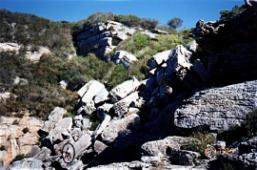
Imbricated boulders stacked against a thirty-metre high cliff face on the south side of Gum Getters Inlet, New South Wales, Australia. Some of these boulders are the size of a boxcar. Note the person circled for scale.
(East Coast)
....These landslides are among the largest on Earth, attaining lengths of 125 miles (200 km) and volumes of 1,200 cubic miles (5,000 cubic km). Moore and others (1989) identified two types of landslides: slumps and debris avalanches. Slumps moved on an overall slope >3�, caused little disruption of the structural coherence of the volcano's flanks, and extended back to the volcanic rift zones and down to the base of the volcanic pile. Slumps may move slowly or surge abruptly forward several meters, causing large earthquakes. The 1868 and 1975 earthquakes, the largest of Hawaii's historic earthquakes, resulted from movement of the Hilina slump in south Hawaii.....
http://volcano.und.edu/vwdocs/vwlessons/evolution/part7.html
thanks, yes I agree there have been ‘wave’ episodes on both the east and west coasts of the Australian Continent, one University study (can’t find the link at the moment) traced lines of huge boulders along the east coast that could only have been deposited by massive water-action.
I’ll get back to you if I find the link.
I found the tone of the posted article a little ridiculous, the thought that emergency services were perhaps standing by with little boats expecting a 500 year event, kinda ticked me off, LOL!

Imbricated boulders stacked against a thirty-metre high cliff face on the south side of Gum Getters Inlet, New South Wales, Australia. Some of these boulders are the size of a boxcar. Note the person circled for scale.
(East Coast)